How AI is Saving the Earth
Category: AI insights
Published date: 10.08.2020
Read time: 6 min
According to data from the United Nations Environment Programme (UNEP) and many other reputable organizations, our planet is currently in a crisis and we need to do something quickly to reverse all of the damage that was caused. The global CO2 equivalent of greenhouse gasses has exceeded 400 ppm, which is the highest level we have seen in the last 800,000 years. Researchers also warn that we are the first generation to fully understand climate change and we are also the last that can do something about it.
In order to slow down the effects of climate change and make the planet more liveable for people all over the world, researchers have developed some interesting AI products that are making a huge impact. Let’s take a look at how AI is saving the planet and some of the technologies that have been created.

Improving the Air Quality
Researchers at Loughborough University in England are working to help cities and lawmakers fight increased levels of air pollution. The goal of the project is to measure and forecast the levels of air quality and the pollution levels up to two days ahead of time to get a better understanding of the weather, seasonal and environmental factors that can impact fine particulate matter. This can be especially useful in countries like China where only 1% of the population can breathe air that can be deemed as safe by the EU. A similar product has been developed by Siemens, called CyAM which helps local authorities keep nitrogen oxide and other fine dust particles under control.
In order for these products to accurately detect high levels of pollution, they need to know exactly what that is. Currently, this is done by feeding historical air quality data and using text annotation to label what exactly can be considered as acceptable and what is cause for alarm. However, since these standards tend to change as time goes on, eventually, the data will need to be updated which will also require additional annotation work to be done.
Using AI to Save Endangered Species
Expanding cities, deforestation, and poaching are among the leading causes of certain animal species becoming extinct. The forest elephant population is radically shrinking in West Africa and the Congo basin mostly due to ivory poaching. In fact, the forest elephant population has decreased by two-thirds and researchers are using AI to help protect them. Conservation Metrics has partnered with Cornell University’s Lab of Ornithology to identify and track forest elephant calls in order to track their movements and monitor the overall population levels. Such data could be especially useful since it could point to potential signs of poaching.
The first stage of the project is to help the machines identify what a real forest elephant sounds like. This will require a human expert or perhaps a team of specialists to identify the sounds necessary for the computer to learn. Then, the system will need to take the elephant migration patterns and identify possible warning signs of ivory poaching. All of this requires detailed levels of data annotation in order for the system to provide the most accurate results.
Ensuring Food Sustainability
The world population growth by 1.1% every year and while this may not seem like a significant rate, that’s 83 million people every year. This poses significant food sustainability issues since there might not be enough to feed the growing population. AI is coming to the rescue here as well by offering smart arming equipment and machinery which can not only increase the amount of food produced but also significantly reduce any harmful impacts on the environment. These include lowering the excessive water usage, agrichemical leaking, and soil erosion. Farmers today are already using drones equipped with computer vision cameras to monitor the growth of the harvest and take timely actions if they see any signs of crop damage.
Robots are also becoming more common in the agriculture sector. They are starting to replace humans in terms of growing and tending to the crops. They use LiDAR sensors to navigate their way around the field and can be programmed to harvest the ripe fruit, water crops, or just roam around all of the plants to make sure they are growing properly.
Mindy Support is Helping Researchs Create Next-Gen Ecological AI Products
All of the products that we looked at require some form of data annotation and Mindy Support is always ready to take such tasks off the shoulders of researchers. We are one of the largest BPO providers in Eastern Europe with 2,000 employees and counting. Our size and location allow us to source and recruit the necessary talent quickly and we can assemble even the largest of teams within a short time period.
Posted by Il’ya Dudkin




